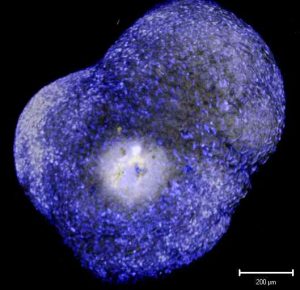
WHARTON’S JELLY REGENERATIVE THERAPY
What are Stem Cells?
Our body is made up of trillions of cells. These cells begin as stem cells which then replicate and mature into many different types of cells in the body. Hematopoietic stem cells give rise to all of the blood cells in our body. For regenerative pain purposes, however, there is a different type of stem cell called mesenchymal stem cells. These mesenchymal stem cells have the ability to help the body repair itself. Mesenchymal stem cells communicate with other damaged cells through a process called “paracrine signaling”. This paracrine signaling process directs and controls the natural regeneration or healing process in our bodies. Nashville Regenerative Therapy utilizes a multitude of regenerative cells to help the body naturally repair itself. Our Nashville Regenerative Therapy provides a natural source to help with pain and various disease processes.
What are the benefits of Stem Cells?
- Stem cells are anti-inflammatory and immunomodulatory. They can decrease swelling and inflammation in the body by downregulating/decreasing the T-1 helper cells (pro-inflammatory cells) and upregulating/increasing the T-2 helper cells (anti-inflammatory cells). Many chronic pain states and systemic diseases have an imbalance of T1/T2 helper cells. Stem cells can help restore balance, thus decreasing inflammation and swelling in the body. This is especially helpful with chronic pain states and many autoimmune disorders.
- Stem cells have trophic/growth factors that help nourish nearby cells that are damaged. They increase blood supply to damaged tissue and can help reduce scar tissue formation.
- Stem cells signal nearby cells that are about to die and help rescue those cells from cell death. They cannot heal cells that are already dead, but they can help save those damaged cells that are about to die.
- Stem cells have antimicrobial properties that help fight bacterial infections. This is very beneficial for wound healing.
- Stem cells have the potential to do many functions that other cells in your body already do. They have the potential to regenerate damaged tissues and help avoid surgery.
- Research studies have shown patients to have significant improvements in pain and function. Studies have also shown improvements on MRI several years after only one stem cell injection. Stem cell therapy is very exciting because it has the potential to help correct the source of your pain.
What medical conditions could potentially benefit from Nashville Regenerative Therapy?
- Osteoarthritis
- Degenerative joint disease
- Knee pain including knee osteoarthritis, degenerative joint disease, meniscal tears and ACL/PCL tears. Research studies have shown cartilage growth and repair after just one stem cell injection.
- Shoulder pain including rotator cuff injuries, arthritis etc.
- Hip pain
- Chronic lower back pain.
How are stem cells and other regenerative helper cells collected?
There are multiple ways that mesenchymal stem cells and other regenerative helper cells can be collected in order to inject or infuse into the body. Stem cells are generally collected from four sources for the purpose of regenerative therapy. These four sources include bone marrow, adipose tissue, amniotic fluid and umbilical cord (blood vs. Wharton’s Jelly).
1. Stem cells can be extracted from your bone marrow. This technique involves puncturing a needle through your bone and extracting the marrow. The marrow is then filtered to get the stem cells.
2. Stem cells can be extracted from your adipose tissue. This technique involves using a needle to remove fat cells from your body. The fat cells are then filtered to obtain stem cells. Both bone marrow aspirate and adipose derived fat stem cells can be a painful and time consuming process. The stem cell count from both of these methods is variable. The cell count varies according to the patient’s age, health, and technique of the provider extracting the stem cells.
3. Stem cells can be extracted from amniotic fluid. This method involves collecting stem cells from amniotic fluid in a pregnant woman. This method has a potential risk of causing an autoimmune reaction in your body due to HLA antigens in cellular debris. The stem cell count from amniotic fluid is variable. These three methods produce a variable number of stem cells. An accurate cellular count is important because some joints require more cells than others.
4. The last way to obtain stem cells and other regenerative helper cells are through the umbilical cord of live, healthy birthed babies. There is both blood and Wharton’s Jelly found inside the umbilical cord. Research studies have shown both sources to have mesenchymal stem cells in addition to other cytokines and growth factors. Research studies have shown Wharton’s Jelly to be a rich source of donor mesenchymal stem cells and other regenerative helper cells. It is also very nutrient rich with growth factors and cytokines that help create a safe environment for the stem cells to flourish.
These Wharton’s Jelly cells are not from aborted fetuses and are in no way related to abortions. The umbilical cord is removed after a live, healthy child is born. The Wharton’s Jelly from within the cord is saved and sent to a tissue bank. The tissue bank runs tests on the Wharton’s Jelly to ensure that it is healthy and free of disease. The Wharton’s Jelly is then frozen and stored at a tissue bank under strict FDA compliance.
Disclaimer: Regenerative therapies such as prolotherapy, platelet rich plasma and different forms of stem cell therapies which are listed above are considered experimental and none of these therapies are FDA approved which is why most insurance companies do not currently cover these therapies. There is however an abundance of research over the past several decades showing benefits for these various forms of regenerative therapies.
Which type of regenerative cells does Nashville Regenerative Therapy use?
Nashville Regenerative Therapy uses umbilical cord Wharton’s Jelly derived regenerative cells. We believe that cord Wharton’s Jelly is the superior method for extracting regenerative cells. These umbilical cord jelly cells are young, healthy and robust cells. Regenerative cells from bone marrow and adipose tissue are the same age as the person donating them. HLA antigens are attached to cells and are what our bodies use to recognize a cell as being foreign and therefore reject. These umbilical cord jelly cells do not have HLA antigens attached to them. This means that an adverse reaction to the cells from umbilical cord jelly is far less likely and much safer.

Umbilical cord derived Stem Cell with fluorescent staining
Another advantage of umbilical cord jelly derived cells is that the regenerative cell count is more accurate and customizable for individual needs. For example, a large joint would require more cells than a smaller joint would. We can approximate the volume of Wharton’s Jelly regenerative cells you may need for your specific disease process. We offer Nashville Regenerative Therapy at our Nashville and Hendersonville interventional pain management clinics.
Final comments
We believe that regenerative medicine with treatments such as Wharton’s Jelly are the future of medicine, personal health and longevity. Nashville Regenerative Therapy is an exciting treatment that has the potential to help with knee pain, back pain, hip pain and shoulder pain. Dr. Brad Wilson, an interventional pain specialist, would be happy to discuss whether Nashville Regenerative Therapy could help your pain. The goal for our patients at our interventional pain clinics is to help reduce pain, improve function and improve quality of life. Nashville Regenerative Therapy has the potential to help with all of these. If you would like more information or would like to set up an appointment to discuss our Nashville Regenerative Therapy with one of our board-certified physicians, please call us at Interventional Pain Center (615) 972-1100 located in Nashville and Hendersonville, TN.



